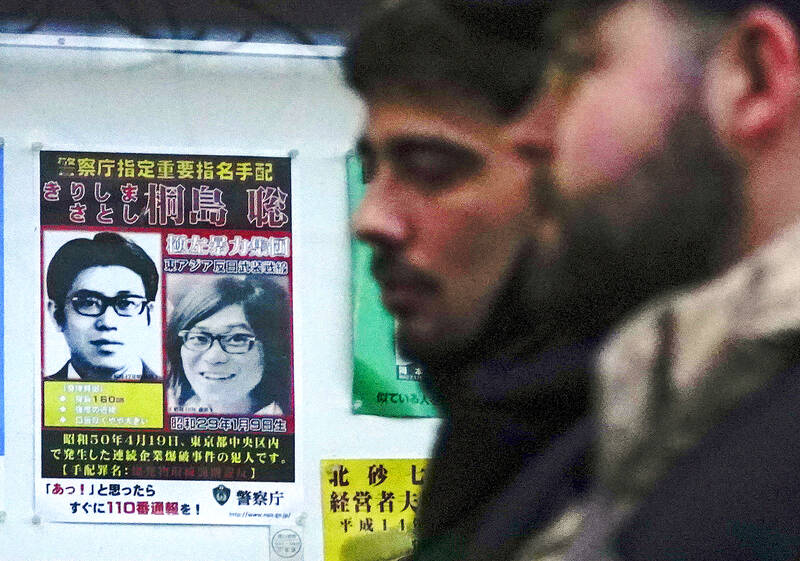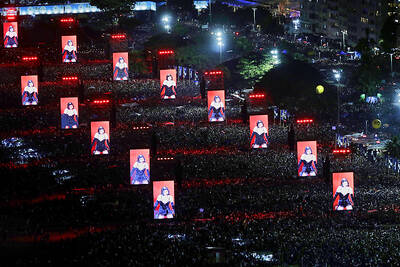Satoshi Kirishima spent almost half a century evading arrest, until mortality intervened.
As deathbed confessions go, his was astonishing: Having lived a double life as a construction worker, the 70-year-old was admitted last month to a hospital near Tokyo where he told staff he was one of Japan’s most-wanted fugitives.
In a more recent image provided to Japanese media by an acquaintance, it is just possible to discern a resemblance with the black-and-white photograph that has adorned Japanese police boxes for decades showing a bespectacled, smiling university student with shoulder-length hair.

Photo: EPA-EFE
While he shared details of his family and his organization that only he could have known, it was not until this week that DNA evidence confirmed that the terminally ill patient was Kirishima, part of a radical group responsible for a nine-month reign of terror in the mid-1970s that shook Japan.
His decision to turn himself in rekindled collective memories of a time when well-organized left-wing extremists posed a serious threat to the public, in Japan and overseas.
As a member of the sasori (scorpion) unit of the East Asia Anti-Japan Armed Front, Kirishima allegedly planted and detonated a homemade bomb that damaged a building in the Ginza neighborhood of Tokyo’s Chuo ward in April 1975. There were no casualties.
He was also suspected of involvement in four other attacks the same year targeting major Japanese corporations the group identified as “collaborators” in Japan’s militarist misadventures in the first half of the 20th century.
In the most notorious incident, the group planted a bomb at the Tokyo headquarters of Mitsubishi Heavy Industries, killing eight people and injuring more than 360 others, apparently because the firm had supplied US forces during the Vietnam war. It remained Japan’s deadliest terrorist attack until the Aum Shinikyo doomsday cult released sarin gas in the Tokyo subway in 1995.
Shortly before he died of stomach cancer late last month at the same hospital he had attended as an outpatient for about a year, Kirishima told staff: “I want to meet my death with my real name,” adding that he regretted his part in the attacks.
While police have referred the bombing cases to prosecutors, Kirishima’s death means the families of his group’s victims would never get their day in court. It has also forced investigators to establish how a high-profile criminal was able to hide in plain sight for 49 years.
In May 1975, police arrested eight people, including Masashi Daidoji, over their involvement in the attacks. He and one other were sentenced to hang, but Daidoji died of cancer in May 2017 while on death row.
Born in Hiroshima Prefecture, Kirishima attended a local school, beginning his life as a political extremist while studying law at Meiji Gakuin University in Tokyo.
His confession means it has at least been possible to form a clearer picture of what appears to have been a modest, blameless, existence during his decades on the run.
Going by the name Hiroshi Uchida, he spent about 40 years working for a building firm in Fujisawa, a city south of Tokyo. He reportedly avoided bank transactions and asked to be paid in cash to avoid leaving a paper trail that could lead to his capture. He did not have a driver’s license, cellphone or health insurance, and paid for hospital treatment out of his own pocket.
“Uchida” visited his local public bath and dropped into a bar — where he was affectionately known as “Ucchi” — to drink beer and listen to rock music, the Yomiuri Shimbun reported, adding that he shared little about himself with fellow drinkers.
Kirishima might have found closure of sorts, but the families of his victims voiced frustration that he had waited so long to unburden himself.
For one relative, whose then 23-year-old sister was killed in the Mitsubishi bombing, his mea culpa had come “too late,” he told the Yomiuri.

Kehinde Sanni spends his days smoothing out dents and repainting scratched bumpers in a modest autobody shop in Lagos. He has never left Nigeria, yet he speaks glowingly of Burkina Faso military leader Ibrahim Traore. “Nigeria needs someone like Ibrahim Traore of Burkina Faso. He is doing well for his country,” Sanni said. His admiration is shaped by a steady stream of viral videos, memes and social media posts — many misleading or outright false — portraying Traore as a fearless reformer who defied Western powers and reclaimed his country’s dignity. The Burkinabe strongman swept into power following a coup in September 2022

‘FRAGMENTING’: British politics have for a long time been dominated by the Labor Party and the Tories, but polls suggest that Reform now poses a significant challenge Hard-right upstarts Reform UK snatched a parliamentary seat from British Prime Minister Keir Starmer’s Labor Party yesterday in local elections that dealt a blow to the UK’s two establishment parties. Reform, led by anti-immigrant firebrand Nigel Farage, won the by-election in Runcorn and Helsby in northwest England by just six votes, as it picked up gains in other localities, including one mayoralty. The group’s strong showing continues momentum it built up at last year’s general election and appears to confirm a trend that the UK is entering an era of multi-party politics. “For the movement, for the party it’s a very, very big

ENTERTAINMENT: Rio officials have a history of organizing massive concerts on Copacabana Beach, with Madonna’s show drawing about 1.6 million fans last year Lady Gaga on Saturday night gave a free concert in front of 2 million fans who poured onto Copacabana Beach in Rio de Janeiro for the biggest show of her career. “Tonight, we’re making history... Thank you for making history with me,” Lady Gaga told a screaming crowd. The Mother Monster, as she is known, started the show at about 10:10pm local time with her 2011 song Bloody Mary. Cries of joy rose from the tightly packed fans who sang and danced shoulder-to-shoulder on the vast stretch of sand. Concert organizers said 2.1 million people attended the show. Lady Gaga

SUPPORT: The Australian prime minister promised to back Kyiv against Russia’s invasion, saying: ‘That’s my government’s position. It was yesterday. It still is’ Left-leaning Australian Prime Minister Anthony Albanese yesterday basked in his landslide election win, promising a “disciplined, orderly” government to confront cost-of-living pain and tariff turmoil. People clapped as the 62-year-old and his fiancee, Jodie Haydon, who visited his old inner Sydney haunt, Cafe Italia, surrounded by a crowd of jostling photographers and journalists. Albanese’s Labor Party is on course to win at least 83 seats in the 150-member parliament, partial results showed. Opposition leader Peter Dutton’s conservative Liberal-National coalition had just 38 seats, and other parties 12. Another 17 seats were still in doubt. “We will be a disciplined, orderly